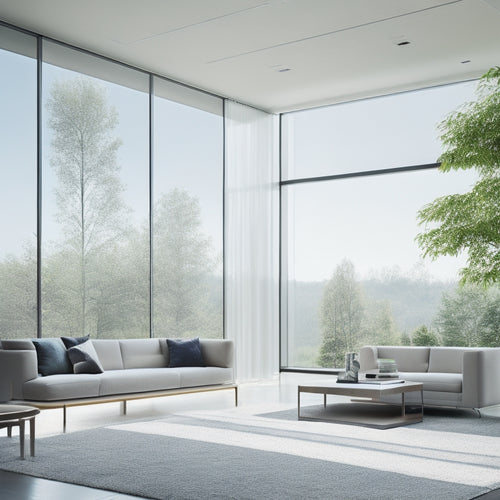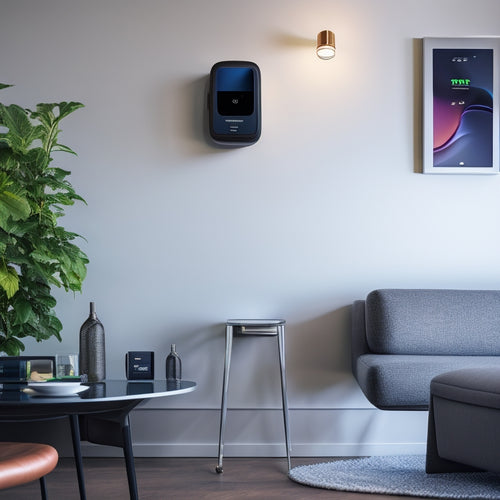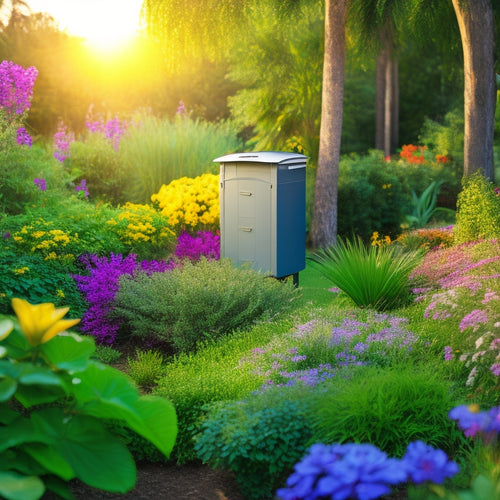
Installing Energy-Efficient LED Fixtures for Modern Homes
Share
You're taking an important step towards changing your modern home into an energy-efficient haven by installing LED fixtures, a move that can slash your energy bills and greatly reduce your carbon footprint. LED lighting consumes minimal energy, lasts up to 25 times longer than traditional bulbs, and is free from toxic chemicals. To get started, choose the right LED products based on color temperature, fixture style, and lumen output, and confirm they meet certifications like Energy Star and UL ratings. With the right tools and a thorough approach, you can successfully install LED fixtures, and by considering ambient, task, and natural lighting, you'll be well on your way to designing a sustainable lighting system that maximizes energy efficiency and enhances your home's ambiance - and there's more to examine in perfecting your LED lighting setup.
Key Takeaways
- Choose LED fixtures with certifications like Energy Star and UL ratings to ensure energy efficiency and safety.
- Consider recessed, surface-mount, pendant, and sconce options to select the right fixture style for your modern home.
- Ensure proper installation by following essential steps, such as checking insulation and airflow for recessed lighting.
- Optimize light distribution and reduce energy waste by placing fixtures in areas that need concentrated light, like task lighting areas.
- Dimming options and smart lighting controls can enhance ambiance and increase energy savings in your modern home.
Benefits of LED Lighting Fixtures
Nearly 90% of the energy consumed by traditional incandescent bulbs is wasted as heat, rather than visible light. By switching to LED lighting fixtures, you'll reduce your energy consumption and enjoy significant cost savings.
LED lighting also has a minimal environmental impact, as it's free from toxic chemicals like mercury and lead. In addition, LED fixtures offer improved aesthetics, with a range of color temperatures and beam angles to suit your design preferences.
Plus, you'll benefit from their longevity, with lifespans up to 25 times longer than incandescent bulbs. Moreover, just like solar-powered EV charging stations reducing carbon footprint, LED lighting also reduces carbon emissions, contributing to a more sustainable future.
This means you'll replace them less often, reducing waste and saving you time and money in the long run. With LED lighting, you'll experience the freedom to focus on what matters most – living your life, not maintaining your light bulbs.
Choosing the Right LED Products
Color Temperature: LED bulbs come in various color temperatures, ranging from warm white (2700K-3000K) to cool white (5000K-6500K) and daylight (6500K and above).
Choose a color temperature that suits your desired ambiance and task requirements. When selecting energy-efficient LED fixtures, it's crucial to take into account the overall energy production and consumption, much like optimizing solar panel array design to maximize energy generation.
This comprehensive approach will help you make an informed decision about your lighting needs.
Fixture Styles: LED fixtures come in a variety of styles, including recessed, surface-mount, pendant, and sconce.
Select a style that complements your home's décor and meets your lighting needs.
Lumen Output: LED bulbs vary in lumen output, which affects their brightness.
Confirm you choose bulbs with sufficient lumens to provide adequate lighting for your spaces.
Certifications and Ratings: Look for LED products with certifications like Energy Star and UL ratings, which guarantee energy efficiency and safety.
LED Fixture Installation Essentials
Your LED fixtures are now selected, and it's time to focus on the installation process. Before you begin, make certain you have the necessary installation tools and understand the specific requirements for your chosen fixture types.
| Fixture Type | Installation Tools | Special Considerations |
|---|---|---|
| Recessed Lighting | Drill, voltage tester, ladder | Verify proper insulation and airflow around fixtures |
| Surface Mount | Screwdriver, wire nuts, level | Confirm stud locations and secure fixtures properly |
| Pendant Lighting | Pendant adapter, wire strippers, pliers | Adjust length and angle to desired position |
| Under Cabinet | Drill, screwdriver, LED tester | Confirm even spacing and secure fixtures to cabinets |
| Outdoor Lighting | Weather-resistant wire, wire connectors, ladder | Follow local electrical codes and waterproofing guidelines |
Remember to always follow the manufacturer's instructions and take necessary safety precautions when installing your LED fixtures.
Designing With Energy Efficiency
Designing an energy-efficient space goes beyond simply selecting LED fixtures; it requires a thorough approach that considers the entire lighting system.
You need to think about how the fixtures will work together to create a sustainable design that minimizes energy consumption. For instance, incorporating solar-powered fast charging hubs, like those found in green energy infrastructure, can greatly reduce carbon footprint and improve energy distribution.
When designing with energy efficiency in mind, consider the following key factors:
-
Ambient lighting: Use LED fixtures to create a warm and inviting atmosphere while reducing energy usage.
-
Task lighting: Strategically place fixtures to provide focused lighting where needed, reducing overall energy consumption.
-
Natural light integration: Take advantage of natural light during the day by installing fixtures that adjust their brightness accordingly.
- Smart lighting controls: Incorporate advanced controls that learn your lighting habits and adjust energy usage accordingly, giving you the freedom to live life on your own terms.
Maximizing LED Lighting Potential
As you investigate the world of energy-efficient lighting, it's essential to access the full potential of LED fixtures to reap the most benefits.
To maximize LED lighting potential, you should consider dimming options that allow you to adjust the light levels according to your needs, much like how charger hardware and installation costs vary by type, quantity, and complexity. This feature not only enhances ambiance but also increases energy savings, similar to how peak demand management strategies distribute power effectively during high usage.
Additionally, pay attention to color temperature, which affects the light's warmth and coolness. Warm white LEDs (2700K-3000K) create a cozy atmosphere, while cool white LEDs (3500K-4100K) provide a brighter, more energizing light.
Frequently Asked Questions
Can I Install LED Fixtures in Outdoor or High-Moisture Areas?
You can install LED fixtures in outdoor or high-moisture areas if they're specifically designed for outdoor installation and have moisture resistance, ensuring they can withstand harsh weather conditions and humidity without compromising performance or safety.
Are LED Fixtures Compatible With Dimmer Switches and Smart Home Systems?
You'll find that most LED fixtures are compatible with dimmer switches, but you'll need to check the manufacturer's specifications for compatibility. Additionally, many LED fixtures can seamlessly integrate with smart home systems, allowing you to control and schedule lighting scenes with ease.
How Do I Dispose of Old LED Bulbs and Fixtures Responsibly?
Get thee to a recycling center, good citizen! You'll find programs designed to responsibly dispose of old LED bulbs and fixtures, keeping hazardous waste out of landfills and our planet free from harm.
Can I Use LED Fixtures With Photocells or Motion Sensors?
You can install LED fixtures with photocells or motion sensors to maximize energy savings; just guarantee compatible dimmer switches and follow installation tips, such as proper wiring and sensor placement, to optimize performance and freedom from energy waste.
Do LED Fixtures Require Special Maintenance or Cleaning Routines?
You'll be relieved to know that LED fixtures require minimal maintenance, with a typical lifespan of 25,000 to 50,000 hours; simply dust them regularly and avoid harsh chemicals to guarantee peak performance and extend their lifespan.
Related Posts
-

3 Sun-Powered Automated Shades for Energy-Savvy Homes
You're looking to change your home into an energy-savvy haven, and sun-powered automated shades are an essential step...
-

7 Best EV Battery Health Trackers for Homeowners
You can maximize your electric vehicle's performance and lifespan by leveraging advanced battery health trackers that...
-

Why Choose Solar Composting Toilets for Your Home?
By choosing a solar composting toilet for your home, you'll greatly reduce your environmental impact, slashing your w...


